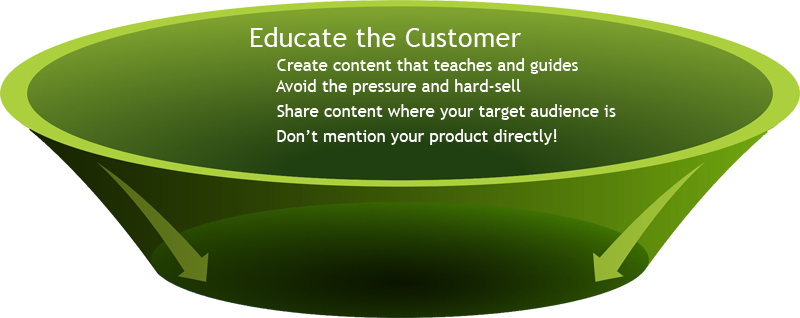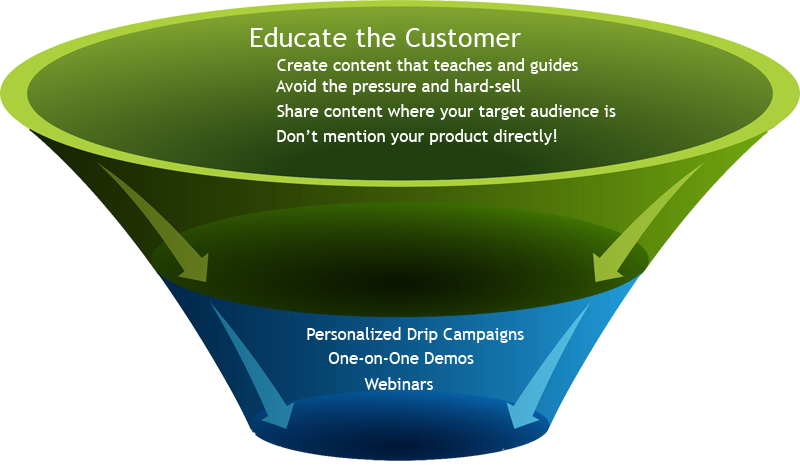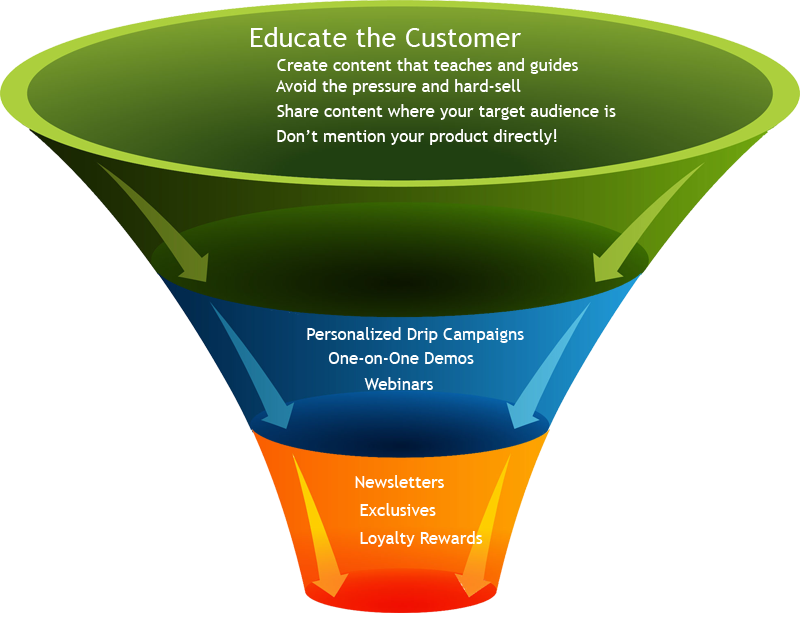In business and in marketing – it’s all about the leads. But today, with so many choices, options and research available, getting the average visitor to take action is a lot more challenging than it used to be.
The core concept of the sales funnel itself hasn’t changed much: you’ll always get more interested prospects at the top than at the bottom. But how you engage with those prospects at every step of the funnel has changed dramatically. Let’s take a closer look at how you can not only entice more users to take the first step, but also brainstorm new and innovative ideas to keep them interested as they make their way through to becoming loyal brand advocates.
The Big Top-of-Funnel Mistake that Nearly Everyone is Making
By far the biggest problem I see marketers and companies of every size and scope making with regards to filling the top of their funnel is this:
Mentioning your product.
“But Sherice!” I can hear you saying, “They need to be aware of the product before they can take action!”
I understand your concern – but let’s look at this from the customer’s perspective. Say I’m looking to invest in a system that provides scalable, cloud-based hosting for my website. Much to the impulsive marketer’s dismay, at this point in the funnel, I don’t want to download a white paper about “How XYZ Company Delivers Scalable Cloud Hosting Solutions”, yet that’s exactly the kind of thing that’s thrown at me from every website.
Educate at the Top of the Funnel First
Take a step back and look at ways to educate, rather than persuade the customer. At this point in the funnel, they’re not looking seriously at solutions. They’re involved in the discovery process – learning what’s out there and what options they have available. You need to prove you’re even worth listening to by illustrating your expertise in a way that’s helpful and knowledgeable, not pushy.
This means filling the top of the funnel with bite-sized, visually scan-able tidbits of content in the medium and format your users prefer. And don’t just wait for the prospect to be the first to act – make sure that your content is hosted anywhere they might go as part of their research and discovery track, whether that’s video, infographics, podcasts or slide shows. They shouldn’t have to go to your site in order to learn more.
Here again, the information you send them shouldn’t be talking about your company directly at all, but rather acting as a guide to help them solve whatever issue or question they have. Going back to my previous example about cloud-based hosting, I may want to know about things like:
- Which apps/services are supported?
- What type of platform is best for my needs?
- What are SaaS, IaaS and PaaS?
- How close is the server to my location?
- What options do I have for databases and storage?
- How much of the server can I control or access myself?
And so on. Even at this “Awareness/Interest stage of the funnel, it’s best to educate and guide rather than push for a sale. Once the interest is piqued, the question then becomes, how can you carry over more of your prospects to the next level of the funnel?
In short, how do you tie this education and guidance to your brand without pushing the consumer away?
Going from Prospect to Purchase
This is the point at which many marketers jump ravenously on the sale, but too often, the pressure is too much, too soon. Remember, they’re considering your offer among many likely competitors so how you differentiate yourself (in a way that’s meaningful to the consumer) is what’s going to warrant them giving you even more serious consideration.
This is where you put your email marketing muscle into action – reach out and learn what your prospect’s biggest concerns are. What do they specifically have questions about? Then set your content and marketing teams about forging relevant, personalized drip campaigns that answer those questions in such a way as to position your product heads and shoulders above the rest.
Common techniques that work best at this time are things like feature lists, comparison charts and pricing breakdowns. Once the consumer sees exactly what they’ll get, what it costs and what it includes, it’s time for the sales team to make their move and reach out to the customer to start planting those “loyalty seeds”.
Things like a free, one-on-one demonstration of the product, a fully featured trial account and tutorials can go a long way in showing the customer that you’ve got their best interests at heart. If you’ve got new features lined up for release, invite them to be one of the first to see how these new updates will benefit their business and how to use them effectively!
Follow Up After the Sale
After the sale may feel like the time to celebrate – but resting on your laurels at this point just makes it easier for competitors to swoop in and convince your newly hard-earned customer that your product or service isn’t the best choice for them. This is why every customer should be looked at more as an ally rather than another notch on your sales belt.
Always be looking for ways where you can create the kind of experience that the customer just can’t help but talk about. It sounds cliché to talk about delivering a phenomenal customer experience, but doing so at every stage of the process – from the website to the technical support to the newsletter and every outreach avenue and touch-point in between is what creates unbreakable loyalty.
Here, things like reward/referral programs, loyalty exclusives, how-to newsletters, social media coupons and other incentives can solidify that loyalty. Don’t just throw sale after sale notification at them – make them an integral part of your brand, and your brand a part of their lifestyle. It doesn’t matter if you’re selling shoes or scalable hosting.
Always be looking for ways to add value – not what you think is valuable, but what the customer finds valuable. Every marketing initiative at each stage in the funnel should continually ask “what can we do to make this even better?”
By asking the right kinds of questions at the right points throughout the sale funnel process, you’ll not only win over more prospects, but you’ll be creating an iron-clad foundation of loyalty and communication that people (even your competition!) can’t help but admire and try to duplicate. Always look for ways to refine your funnel at any point where you find “leaks”. Seek out disconnects where the message doesn’t match the intent or where the content isn’t meeting the reader’s needs. An engaging sales funnel isn’t made of stone: it’s a fluid, ever-changing and adapting product that demonstrates precisely how you put customers first.
Have you created some unique, engaging or compelling content for your sales funnel that customers just can’t stop talking about? Tell us more about it in the comments below!
About the Author: Sherice Jacob helps business owners improve website design and increase conversion rates through compelling copywriting, user-friendly design and smart analytics analysis. Learn more at iElectrify.com and download your free web copy tune-up and conversion checklist today!



No comments:
Post a Comment